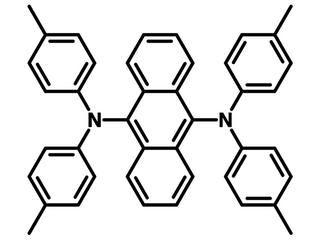TTPA
CAS Number 177799-16-5
Charge Transport Layer Materials, Dopant Materials, Green Dopant Materials, High Purity Sublimed Materials,TTPA, an green dopant material in TADF devices
Available online in sensible quantities for priority dispatch, CAS No. 177799-16-5, Sublimed ≥99.0%
Specifications | Pricing and Options | MSDS | Literature and Reviews
9,10-Bis[N,N-di-(p-tolyl)-amino]anthracene, TTPA, is commonly used as a green dopant material in TADF-OLED devices.
Bearing two triarylamine units, TTPA is also electron-rich in nature. It can be used as a hole-transporting material for OLED, OPV, and perovskite solar cell applications.
General Information
| CAS number | 177799-16-5 |
|---|---|
| Full name | 9,10-Bis[N,N-di-(p-tolyl)-amino]anthracene |
| Chemical formula | C42H36N2 |
| Molecular weight | 568.75 g/mol |
| Absorption | λmax 294, 471 nm in DCM |
| Fluorescence | λem 554 nm in DCM |
| HOMO/LUMO | HOMO = 5.5 eV, LUMO = 3.1 eV [1] |
| Synonyms | TTP1; ATTP |
| Classification / Family | Triarylamine derivatives, Organic electronics, Hole transport layer materials (HTL), Electron-blocking layer materials (EBL), TADF green dopant materials, TADF-OLEDs, Sublimed materials. |
Product Details
| Purity | Sublimed: >99.0% (HPLC) |
|---|---|
| Melting point | TGA: >280 °C (0.5% weight loss) |
| Appearance | Yellow powder/crystals |
*Sublimation is a technique used to obtain ultra pure-grade chemicals. For more details about sublimation, please refer to the Sublimed Materials.
Chemical Structure
Device Structure(s)
| Device structure | ITO/α-NPD (30 nm)/DPEPO (10 nm)/TPBi (40 nm)/1 wt% DBP:10 wt% TTPA:mCP (8 nm)/mCP (2 nm)/DMAC-DPS (7.5 nm)/LiF (0.5 nm)/Al (100 nm) [1] |
|---|---|
| Color | White |
| Max. EQE | 12.1% |
| Max. Power Efficiency | 22 lm W-1 |
| Device structure | ITO/TAPC (35 nm)/1 wt%-TTPA:50 wt%-ACRXTN:mCP (15 nm)/TPBi (65 nm)/LiF (0.8 nm)/Al (100 nm) [2] |
|---|---|
| Color | Green |
| Max Current Efficiency | 45 cd/A |
| Max EQE | 15.8% |
| Max. Power Efficiency | 47 lm W-1 |
| Device structure | ITO/MoO3 (2 nm)/TAPC (40 nm)/TCTA (10 nm)/CzSi (3 nm)/CzSi:Pd-B-1* (10%):TTPA (1%) (20 nm)/TSPO1 (10 nm)/TmPyPb (40 nm)/LiF (1.2 nm)/Al (150 nm) [3] |
|---|---|
| Color | Green |
| Max Current Efficiency | 38.85 cd/A |
| Max EQE | 10.41% |
| Max. Power Efficiency | 38.14 lm W-1 |
*For chemical structure information, please refer to the cited references.
Pricing
| Grade | Order Code | Quantity | Price |
|---|---|---|---|
| Sublimed (>99% purity) | M2129A1 | 250 mg | £250 |
| Sublimed (>99% purity) | M2129A1 | 500 mg | £420 |
| Sublimed (>99% purity) | M2129A1 | 1 g | £680 |
MSDS Documentation
Literature and Reviews
- High-Efficiency White Organic Light-Emitting Diodes Based on a Blue Thermally Activated Delayed Fluorescent Emitter Combined with Green and Red Fluorescent Emitters, T. Higuchi et al., Adv. Mater., 27, 2019–2023 (2015); DOI: 10.1002/adma.201404967.
- High-efficiency organic light-emitting diodes with fluorescent emitters, H. Nakanotani et al., Nat. commun., 5:4016 (2014); DOI: 10.1038/ncomms5016
- Highly luminescent palladium(II) complexes with sub-millisecond blue to green phosphorescent excited states. Photocatalysis and highly efficient PSF-OLEDs, P-K. Chow et al., Chem. Sci., 7, 6083-6098 (2016); DOI: 10.1039/C6SC00462H.

